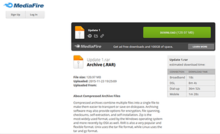MediaFire facts for kids
 |
|
|
Type of site
|
Online backup service |
|---|---|
| Available in | English |
| Area served | Worldwide |
| Owner | MediaFire, LLC |
| Founder(s) |
|
| Commercial | Yes |
| Registration | Not required for downloading or uploading. (1GB file limit for uploading without an account) |
| Launched | October 20, 2006 |
| Current status | Active (Mobile) |
|
Content license
|
Proprietary software (Windows, Mac and Linux clients) |
MediaFire is an online service that helps you store your files, share them with others, and keep them in sync across your devices. It's like having a digital locker in the cloud! This service is based in Shenandoah, Texas, in the United States.
MediaFire was started in June 2006 by Derek Labian and Tom Langridge. You can use MediaFire on many devices, including computers (Windows, Mac, Linux) and phones (Android, iPhone), or simply through your web browser.
Contents
Storing Your Files Online
MediaFire offers different ways to store your files. In 2012, they offered up to 50 GB of free storage. You could start with 10 GB and get more by doing things like installing their apps or sharing on social media.
In April 2014, MediaFire made its professional storage plan even better. They increased the storage from 100 GB to a huge 1 TB (which is 1000 GB!). They also lowered the monthly price for this plan.
If a business uses MediaFire, all the storage for different users in that company can be shared. This makes it easier to manage and pay for. MediaFire's free accounts do not require you to download files often to keep them. This makes it a good choice for just backing up your important files.
MediaFire Apps
MediaFire has special apps that you can use on different devices. These apps make it easy to manage your files.
Apps for Phones and Tablets
MediaFire first released apps for Android phones in January 2013 and for iOS (like iPhones and iPads) in July 2012. These apps were updated in 2014 to work even better.
With the mobile apps, you can easily upload photos and videos you take on your device. You can also access all the files stored in your MediaFire account from anywhere.
Apps for Desktop Computers
MediaFire also had apps for desktop computers, which were first launched in November 2013. These apps worked on macOS and Microsoft Windows computers. They helped you keep your files and folders in sync with your MediaFire account.
These desktop apps also let you share files and folders easily. They could send you notifications and even capture screenshots. You could also choose which specific folders to sync. The desktop apps worked on Windows XP, Vista, 7, and 8, or Mac OS X 10.7 and newer. They needed at least 1 GB of RAM and 600 MB of disk space. MediaFire announced that its desktop sync feature stopped working on July 30, 2016. After that date, you could only use the web version on desktop computers.
Sharing Your Files
MediaFire lets you share files in two main ways: publicly and privately.
Private sharing means you share files directly with another person or a specific group. You can do this by importing contacts or using email. The person who owns the account can even decide if others can only view the files or also make changes to them.
Public sharing means you get a special link that anyone can use to download your file. These public links always allow people to only view or download, not change, the files. MediaFire also supports "one-time links," which can only be used once to download a file.
In 2013, MediaFire added a cool feature: you could stream audio and video files directly through their online file viewer. This means you could watch or listen without downloading the whole file first.
MediaFire's web viewer supports many different types of files, so you can view them right in your browser:
- Image files like JPEG, .PNG, .GIF, .TIFF, and .BMP.
- Video files such as WebM, .MPEG4, .MOV, .AVI, .MPEGPS, .WMV, .FLV, .3GP, .OGG, .VOB, and .MP4.
- Simple text files (..TXT).
- Code files like .CSS, .HTML, .PHP, .C, .CPP, .H, .HPP, .JS, .java, and .pl.
- Microsoft Word documents (..DOC and .DOCX).
- Microsoft Excel spreadsheets (..XLS and .XLSX).
- Microsoft PowerPoint presentations (..PPT and .PPTX).
- Adobe .PDF files.
Developer Platform
In July 2014, MediaFire made its platform, API (Application Programming Interface), and Developer Center available to the public. An API is like a set of rules that lets different computer programs talk to each other. This meant that other developers could create their own apps and tools that work with MediaFire.
Along with detailed instructions for using the API, they also opened a public forum for developers. They released special toolkits (SDKs) for Java, JavaScript, and Objective-C. A C++ SDK was also announced.
See also
 In Spanish: MediaFire para niños
In Spanish: MediaFire para niños
- Mega
- RapidShare
- Google Drive
- OneDrive
- Dropbox

